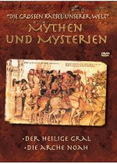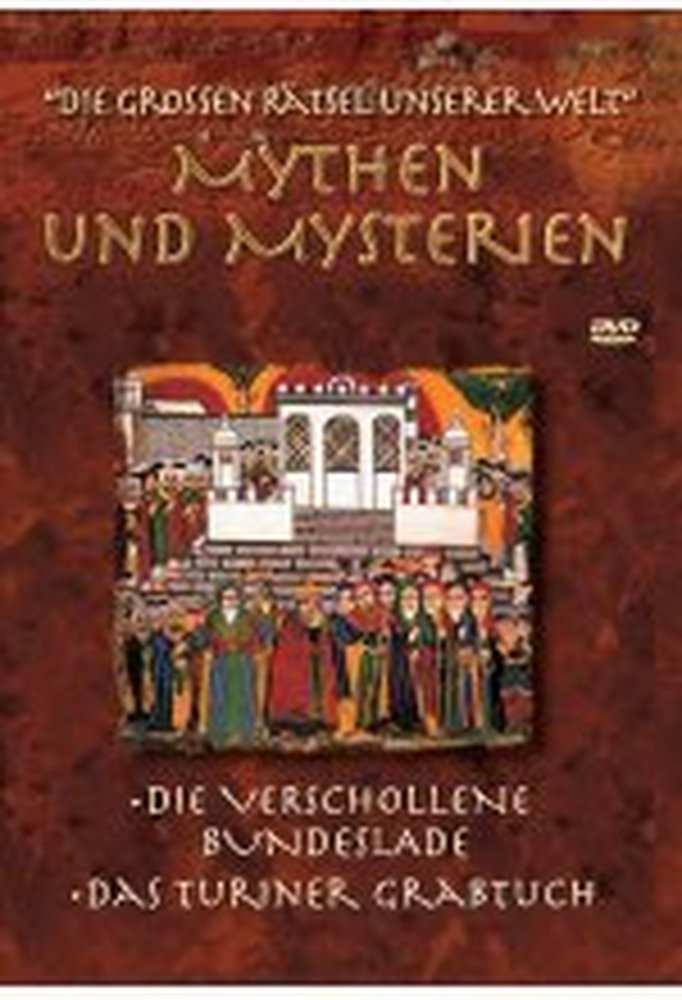Auf verschlungenen Pfaden führt die Reihe "Die großen Rätsel unserer Welt" in die aufregende Welt der Mythen und Mysterien. Sie gibt Antworten auf Fragen, die seit Jahrhunderten die Phantasie der Menschen beschäftigen. Wohin verschwand die Bundeslade mit den Zehn Geboten Gottes? Ist tatsächlich Jesus Christus auf dem Turiner Leichentuch zu sehen? War der Gral ein geheimnisvoller Schatz der Katharer? Was enthüllen die Schriftrollen vom Toten Meer?
Die komplette Reihe mit den Folgen:
01. Die Sintflut und die Suche nach Atlantis
Gab es eine biblische Sintflut? Weltweit berichten Sagen davon. Die bekannteste stammt von dem griechischen Philosophen Platon, der den Mythos um die legendäre Insel Atlantis gebar. Gab es eine Zivilisation vor Adam und Eva? Die Spurensuche: Alte Karten, die die Küste der Antarktis lange vor ihrer Entdeckung zeigen; Olmeken-Statuen in Mexiko; die Verwitterungsspuren der Sphinx in Gizeh, die ihre wahre Entstehung auf über 10.000 Jahre zurückdatieren. Eine aufregende Reise in die Zeit vor unserer Menschengeschichte, ein spannendes Mosaik auf der Suche nach Atlantis. Mit Bestseller-Autor Colin Wilson.
02. Qumran - Das Geheimnis der Schriftrollen
Was ein Ziegenhirte in den Felsenhöhlen hoch über dem Toten Meer zufällig 1947 entdeckte, brachte viele als gesichert geltende Auffassungen über das frühe Christentum und sein Verhältnis zum Jüdischen Glauben ins Wanken. Die geheime Auswertung der Text-Fragmente dauerte über 40 Jahre und gab Anlass zu wilden Spekulationen. Heute ist die "Verschlusssache Jesus" allen Wissenschaftlern zugänglich. Das Geheimnis der Qumran-Rollen ist damit aber immer noch nicht enthüllt.
03.Der Gral
Ist der Heilige Gral, den Chrétien de Troyes und Wolfram Eschenbach in ihrem "Parzival"-Epen besungen haben, identisch mit jenem "Schatz", den die Katharer im 13. Jahrhundert in einer der unzähligen Höhlen nahe der "Gralsburg" Mont-ségur in Languedoc versteckt haben sollen? Welche düsteren Ideologien sind mit dem Gral verbunden, dass sich Jahrhunderte später Nazi-Phantasten auf die Suche nach ihm begaben: Himmlers SS-Schergen als Tempel-Ritter einer neuen Zeit - die reine Rasse in einem kurzen 1.000-jährigen Reich.
04. Die Arche Noah
"Der Berg des Schiffes" wurde der Ararat schon in alter Zeit genannt. War auf einem Gipfel an der Grenze der Türkei, des Irans und Armeniens Noahs Arche gestrandet? Einige betrachten die Sintflut als Legende, andere glauben an eine göttliche Strafe für die Menschen. Die vernichtende Sintflut findet sich bei vielen Hochkulturen: den alten Ägyptern, den Sumerern, in Indien, und überall taucht eine Arche auf, mit der Auserwählte Gottes Zorn entkommen.
05. Geheimnisse in der Wüste
Den Süden der peruanischen Wüste markieren riesige Scharrbilder und schnurgerade, kilometerlange Linien, die nur aus der Luft komplex zu erkennen sind. War das 13.000 qkm große Gebiet bei Nazca einst Landeplatz Außerirdischer oder gar der Götter? Maria Reiche widmete 50 Jahre ihres Lebens der Erforschung dieser rätselhaften Zeichen einer versunkenen Kultur, die noch heute in den Mythen der Andenindios nachschwingt.
06. Das Geheimnis der Inkas
1532 nahmen 170 spanische Soldaten das größte Königreich auf Erden im Handstreich - das Reich der Inkas. Der amerikanische Harvard-Gelehrte William Sullivan lüftet das Geheimnis dieser Erforschung. Schritt für Schritt entziffert er die Mythen der Inka und ihre Begabung, die Himmelsmechanik zu deuten. Ihre philosophische Zuordnung von Zeit und Raum war beeindruckend: "Wenn Ereignisse am Himmel das Leben auf Erden beeinflussen können, warum sollte das dann nicht auch umgekehrt gelten?"
Als die Spanier in das Inka-Reich eindrangen, sahen die Inkas darin das Signal für ihr Ende. Sie ergaben sich ohne jeglichen Widerstand und überließen Eldorado den fremden Glücksrittern.
07. Das Geheimnis der Pyramiden
Das letzte Wunder der alten Welt ragt in Stein erstarrt aus der Wüste Ägyptens: Die Pyramiden von Gizeh geben immer neue Rätsel auf. Wie konnten sie in nur 80 Jahren erbaut werden? Waren die Monumente Gräber oder astronomische Erdzeichen, eingebunden in eine "Sternen"-Religion, der Pharaonen-Dynastien? Neueste Untersuchungen weisen darauf hin, dass die Pyramiden und die Sphinx einige tausend Jahre älter als die Pharaonenreiche sind. Gab es eine menschliche Zivilisation in grauer Vorzeit? Muss deshalb unsere Geschichte neu geschrieben werden?
08. Gent - Das gestohlene Lamm Gottes
1934 erschütterte ein spektakulärer Kunstraub die Welt: Damals wurde ein Flügel des berühmten Genter Altars von Hubert und Jan van Eyck gestohlen, der seitdem nie wieder aufgetaucht ist. Die Entzifferung rätselhafter Inschriften auf den Gemälden der von Eycks wirft ein neues Licht auf die Hintergründe dieses mysteriösen Diebstahls sowie die Motive der Täter und Auftraggeber. Was erhofften sich die neuen Nazi-Herren im gerade heraufdämmernden "Dritten Reich" vom Lamm Gottes?
09. Der Mythos von Osiris
Die bahnbrechenden Erkenntnisse des Autors Robert Bauval über die Verbindung zwischen den rätselhaften Pyramide von Gizeh und der uralten Legende von Osiris und Isis veränderten unsere Sichtweise des Alten Ägyptens. Der Mythos, das Herzstück der Religion, beschreibt, wie in längst vergangenen Zeiten weit vor den ersten Pharaonen die Götter Ägypten aus dem Chaos erschufen. Bauval folgt den Spuren dieses auch heute noch gegenwärtigen Mythos durch die Jahrtausende und enthüllt eine Parallelreligion.
10. Das Wunder von Santiago de Compostella
Auf dem "Camino de Santiago", dem alten Pilgerweg nach Santiago de Compostella, hat der Apostel Jakobus der Ältere zahlreiche Wunder bewirkt, von denen Pilger, Kleriker und das ganze Volk noch heute erzählen. Im Jahre 44 n.Chr., in Jerusalem enthauptet, brachten Jünger des Apostels seine sterblichen Überreste nach Spanien zurück. Im 9. Jahrhundert wies ein geheimnisvolles Licht zu seinem Grab. Ein gewaltiger Pilgerstrom setzte im 11. Jahrhundert ein, versiegte aber im Laufe der Zeit. Eine wundersame Wiederbelebung begann Mitte des 20. Jahrhunderts. Was sind heute die mysteriösen Beweggründe der hunderttausend Pilger auf dem "Jakobs-Weg"?
11. Die verschollene Bundeslade
Als die Babylonier im Jahre 587 v.Chr. den Tempel in Jerusalem zerstörten, verlor sich die Spur eines der größten Heiligtümer des jüdischen Volkes - der Bundeslade, jenes sagenumwobenen Schreins, in dem Moses die Zehn Gebote in das gelobte Land schaffen sollte und den König Salomon Jahrhunderte später im Allerheiligsten des Tempels aufstellen ließ. Die Spuren führten nach vielen Irrwegen nach Aksem, der heiligen Stadt der Äthiopier.
12. Das Turiner Grabtuch
Drei Millionen Menschen pilgerten 1978 nach Turin, um im Dom das Heiligtum des Grabtuches Christi zu sehen. Es erfüllte ein Grundbedürfnis des Glaubens: Wenn schon Gottvater unfassbar war, so wollte man sich doch zumindest den fleischgewordenen Gottessohn bildlich vorstellen können. Doch ist der Körper und das Antlitz wirklich authentisch oder haben wir es mit einer geschickten Fälschung aus dem 14. Jahrhundert zu tun? Bis heute wog der Kampf zwischen Gläubigen und Wissenschaftlern, die mit Radio-Karbonuntersuchung, photographischen Analysen und Pollenzuordnung dem Geheimnis der Reliquie auf der Spur sind.
Weiterlesen »
On winding paths, the series "The Great Mysteries of Our World" leads into the exciting world of myths and mysteries. It provides answers to questions that have occupied people's imaginations for centuries. Where did the Ark of the Covenant with the Ten Commandments of God disappear to? Is Jesus Christ really to be seen on the Shroud of Turin? Was the Grail a mysterious treasure of the Cathars? What do the Dead Sea Scrolls reveal?
The complete series with the consequences:
01. The Flood and the Search for Atlantis
Was there a biblical flood? Legends around the world tell of it. The most famous comes from the Greek philosopher Plato, who gave birth to the myth of the legendary island of Atlantis. Was there a civilization before Adam and Eve? The search for clues: Old maps showing the coast of Antarctica long before it was discovered; Olmec statues in Mexico; the weathering traces of the Sphinx in Giza, which date their true formation back to over 10,000 years. An exciting journey into the time before our human history, an exciting mosaic in search of Atlantis. With bestselling author Colin Wilson.
02. Qumran - The Mystery of the Scrolls
What a goatherd discovered by chance in the rock caves high above the Dead Sea in 1947 shook many accepted views about early Christianity and its relationship to the Jewish faith. The secret evaluation of the text fragments took over 40 years and gave rise to wild speculation. Today, the "classified information of Jesus" is accessible to all scientists. However, the secret of the Qumran scrolls has still not been revealed.
03.The Grail
Is the Holy Grail, which Chrétien de Troyes and Wolfram Eschenbach sang about in their "Parzival" epic, identical with the "treasure" that the Cathars are said to have hidden in one of the countless caves near the "Grail Castle" Mont-ségur in Languedoc in the 13th century? What gloomy ideologies are associated with the Grail that centuries later Nazi fantasists went in search of it: Himmler's SS henchmen as Knights Templar of a new age - the pure race in a short 1,000-year Reich.
04. Noah's Ark
"The mountain of the ship" Ararat was already called in ancient times. Was Noah's Ark stranded at a summit on the border of Turkey, Iran and Armenia? Some consider the Flood a legend, others believe in a divine punishment for mankind. The devastating Flood can be found in many advanced civilizations: the ancient Egyptians, the Sumerians, in India, and everywhere an ark appears with which the elect escape God's wrath.
05. Secrets in the Desert
The south of the Peruvian desert is marked by huge scratches and dead straight, kilometre-long lines that can only be seen from the air. Was the 13,000 square kilometer area near Nazca once a landing site for aliens or even the gods? Maria Reiche dedicated 50 years of her life to researching these enigmatic signs of a sunken culture, which still resonates today in the myths of the Andean Indians.
06. The Secret of the Incas
In 1532, 170 Spanish soldiers took the largest kingdom on earth in a coup d'état - the empire of the Incas. The American Harvard scholar William Sullivan reveals the secret of this research. Step by step, he deciphers the myths of the Incas and their talent for interpreting celestial mechanics. Her philosophical assignment of time and space was impressive: "If events in the sky can influence life on earth, why shouldn't the reverse be true?"
When the Spaniards invaded the Inca Empire, the Incas saw it as the signal for their end. They surrendered without any resistance and left Eldorado to the foreign soldiers of fortune.
07. The Mystery of the Pyramids
The last wonder of the ancient world rises frozen in stone from the desert of Egypt: the pyramids of Giza pose ever new puzzles. How could they be built in just 80 years? Were the monuments tombs or astronomical earth signs, integrated into a "star" religion, the pharaoh dynasties? Recent research indicates that the pyramids and the Sphinx are several thousand years older than the Pharaohs' empires. Was there a human civilization in ancient times? Does this mean that our history has to be rewritten?
08. Ghent - The Stolen Lamb of God
In 1934, a spectacular art theft shook the world: At that time, a wing of the famous Ghent Altarpiece was stolen by Hubert and Jan van Eyck, which has never resurfaced since. The deciphering of mysterious inscriptions on the von Eycks' paintings sheds new light on the background of this mysterious theft as well as the motives of the perpetrators and clients. What did the new Nazi masters hope for from the Lamb of God in the "Third Reich" that was just dawning?
09. The Myth of Osiris
Author Robert Bauval's groundbreaking insights into the connection between the enigmatic Pyramid of Giza and the ancient legend of Osiris and Isis changed our view of Ancient Egypt. The myth, the heart of the religion, describes how, in times long past, long before the first pharaohs, the gods created Egypt out of chaos. Bauval follows the traces of this myth, which is still present today, through the millennia and reveals a parallel religion.
10. The Miracle of Santiago de Compostella
On the "Camino de Santiago", the old pilgrimage route to Santiago de Compostella, the Apostle James the Elder performed numerous miracles that pilgrims, clerics and the whole people still tell today. In 44 A.D., beheaded in Jerusalem, disciples of the apostle brought his mortal remains back to Spain. In the 9th century, a mysterious light pointed to his tomb. A huge stream of pilgrims began in the 11th century, but dried up over time. A miraculous revival began in the middle of the 20th century. What are the mysterious motives of the hundred thousand pilgrims on the "Way of St. James" today?
11. The Lost Ark of the Covenant
When the Babylonians destroyed the Temple in Jerusalem in 587 BC, the trace of one of the largest sanctuaries of the Jewish people - the Ark of the Covenant, the legendary shrine in which Moses was to bring the Ten Commandments to the promised land and which King Solomon had set up in the Holy of Holies of the Temple centuries later - was lost. After many wrong turns, the tracks led to Aksem, the holy city of the Ethiopians.
12. The Shroud of Turin
Three million people made a pilgrimage to Turin in 1978 to see the sanctuary of the Shroud of Christ in the cathedral. It fulfilled a basic need of faith: if God the Father was incomprehensible, people at least wanted to be able to visualize the Son of God made flesh. But is the body and face really authentic or are we dealing with a clever forgery from the 14th century? To this day, the battle between believers and scientists, who are on the trail of the secret of the relic with radiocarbon examination, photographic analyses and pollen attribution, has weighed up to this day.
More »




















































